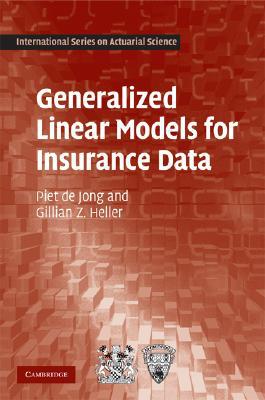

 |

|

Sold Out
Book Categories |
Preface ix
1 Insurance data 1
1.1 Introduction 2
1.2 Types of variables 3
1.3 Data transformations 4
1.4 Data exploration 6
1.5 Grouping and runoff triangles 10
1.6 Assessing distributions 12
1.7 Data issues and biases 13
1.8 Data sets used 14
1.9 Outline of rest of book 19
2 Response distributions 20
2.1 Discrete and continuous random variables 20
2.2 Bernoulli 21
2.3 Binomial 22
2.4 Poisson 23
2.5 Negative binomial 24
2.6 Normal 26
2.7 Chi-square and gamma 27
2.8 Inverse Gaussian 29
2.9 Overdispersion 30
Exercises 33
3 Exponential family responses and estimation 35
3.1 Exponential family 35
3.2 The variance function 36
3.3 Proof of the mean and variance expressions 37
3.4 Standard distributions in the exponential family form 37
3.5 Fitting probability functions to data 39
Exercises 41
4 Linear modeling 42
4.1 History and terminology of linear modeling 42
4.2 What does "linear" in linear model mean? 43
4.3 Simple linear modeling 43
4.4 Multiple linear modeling 44
4.5 The classical linear model 46
4.6 Least squares properties under the classical linear model 47
4.7 Weighted least squares 47
4.8 Grouped and ungrouped data 48
4.9 Transformations to normality and linearity 49
4.10 Categorical explanatory variables 51
4.11 Polynomial regression 53
4.12 Banding continuous explanatory variables 54
4.13 Interaction 55
4.14 Collinearity 55
4.15 Hypothesis testing 56
4.16 Checks using the residuals 58
4.17 Checking explanatory variable specifications 60
4.18 Outliers 61
4.19 Model selection 62
5 Generalized linear models 64
5.1 The generalized linear model 64
5.2 Steps in generalized linearmodeling 65
5.3 Links and canonical links 66
5.4 Offsets 66
5.5 Maximum likelihood estimation 67
5.6 Confidence intervals and prediction 70
5.7 Assessing fits and the deviance 71
5.8 Testing the significance of explanatory variables 74
5.9 Residuals 77
5.10 Further diagnostic tools 79
5.11 Model selection 80
Exercises 80
6 Models for count data 81
6.1 Poisson regression 81
6.2 Poisson overdispersion and negative binomial regression 89
6.3 Quasi-likelihood 94
6.4 Counts and frequencies 96
Exercises 96
7 Categorical responses 97
7.1 Binary responses 97
7.2 Logistic regression 98
7.3 Application of logistic regression to vehicle insurance 99
7.4 Correcting for exposure 102
7.5 Grouped binary data 105
7.6 Goodness of fit for logistic regression 107
7.7 Categorical responses with more than two categories 110
7.8 Ordinal responses 111
7.9 Nominal responses 116
Exercises 119
8 Continuous responses 120
8.1 Gamma regression 120
8.2 Inverse Gaussian regression 125
8.3 Tweedie regression 127
Exercises 128
9 Correlated data 129
9.1 Random effects 131
9.2 Specification of within-cluster correlation 136
9.3 Generalized estimating equations 137
Exercise 140
10 Extensions to the generalized linear model 141
10.1 Generalized additive models 141
10.2 Double generalized linear models 143
10.3 Generalized additive models for location, scale and shape 143
10.4 Zero-adjusted inverse Gaussian regression 145
10.5 A mean and dispersion model for total claim size 148
Exercises 149
Appendix 1 Computer code and output 150
A1.1 Poisson regression 150
A1.2 Negative binomial regression 156
A1.3 Quasi-likelihood regression 159
A1.4 Logistic regression 160
A1.5 Ordinal regression 169
A1.6 Nominal regression 175
A1.7 Gamma regression 178
A1.8 Inverse Gaussian regression 181
A1.9 Logistic regression GLMM 183
A1.10 Logistic regression GEE 185
A1.11 Logistic regression GAM 187
A1.12 GAMLSS 189
A1.13 Zero-adjusted inverse Gaussian regression 190
Bibliography 192
Index 195
Login|Complaints|Blog|Games|Digital Media|Souls|Obituary|Contact Us|FAQ
CAN'T FIND WHAT YOU'RE LOOKING FOR? CLICK HERE!!! X
 You must be logged in to add to WishlistX
 This item is in your Wish ListX
 This item is in your CollectionGeneralized Linear Models for Insurance Data
X
 This Item is in Your InventoryGeneralized Linear Models for Insurance Data
X
 You must be logged in to review the productsX
 X
 X

Add Generalized Linear Models for Insurance Data, This is the only book actuaries need to understand generalized linear models (GLMs) for insurance applications. GLMs are used in the insurance industry to support critical decisions. Until now, no text has introduced GLMs in this context or addressed the , Generalized Linear Models for Insurance Data to the inventory that you are selling on WonderClubX
 X

Add Generalized Linear Models for Insurance Data, This is the only book actuaries need to understand generalized linear models (GLMs) for insurance applications. GLMs are used in the insurance industry to support critical decisions. Until now, no text has introduced GLMs in this context or addressed the , Generalized Linear Models for Insurance Data to your collection on WonderClub |